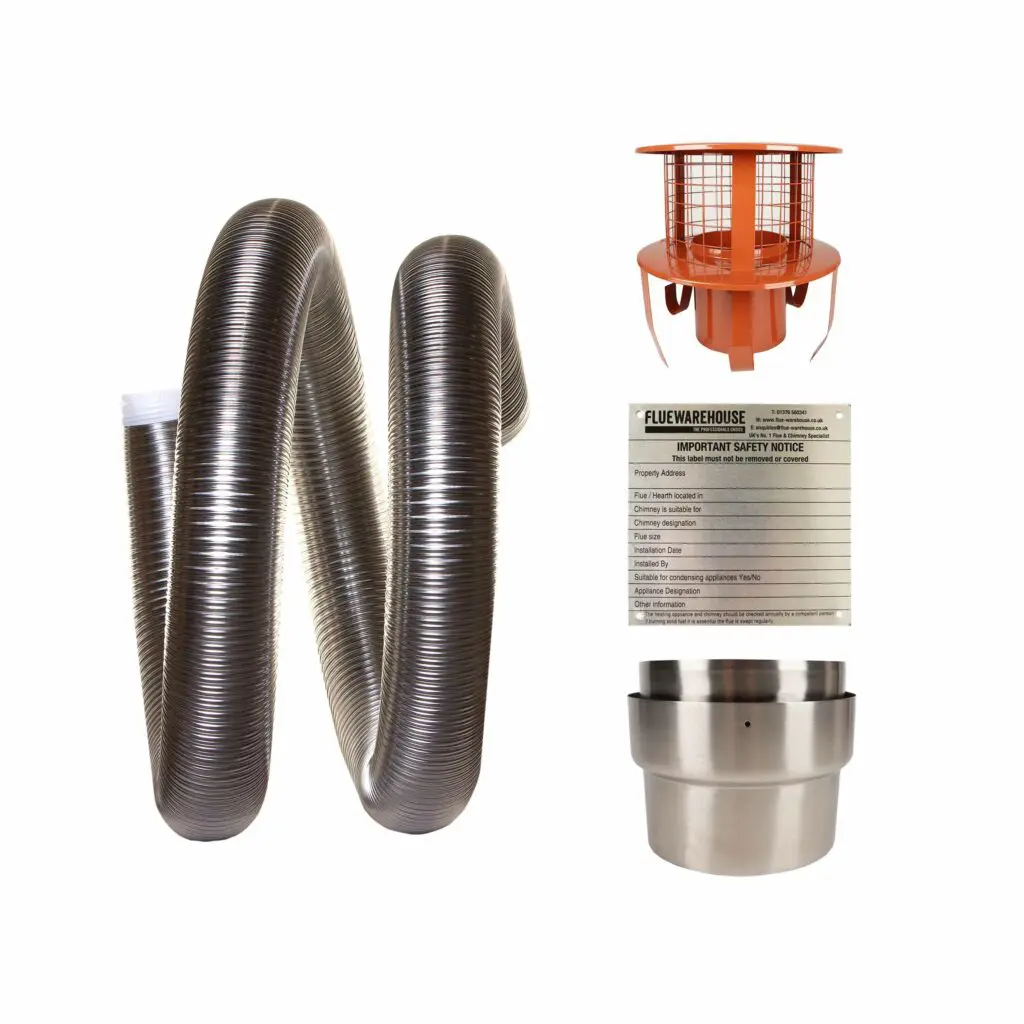Lining an existing brick chimney is the easiest, and most cost effective, of the flue systems available however, for a safe and legal installation, we only advise using the services of a HETAS registered engineer or alternative member of the Competent Persons Scheme. Should you wish to undertake the work yourself, you must inform the local Planning Office (Building Control Body) of the intended work and they will advise how to proceed in-line with their requirements.
Shop Flexible Chimney Flue Liner

Firstly, what diameter and length of Liner do you need? As with all flue systems, the building regulations dictate a legal minimum diameter of Flexible Liner you must install for your stove, and this is based upon the size of the stove’s outlet collar and whether it is DEFRA approved or not. As a rule of thumb, if your stove is DEFRA approved, you can install minimum 5” (125mm) diameter Liner and if it is not DEFRA approved, then you must install minimum 6” (150mm) diameter Liner. The one caveat to this is your liner can never have a narrower diameter than that of the stove outlet itself. Here at Flexble Flue Liners, we manufacture and supply 4″ (100mm), 5″ (125mm), 6″ (150mm), 7″ (175mm) and 8″ (200mm) Flexible Liners.
The length of Liner you need is simply determined by the height of your chimney. You can measure this yourself or ask your chimney sweep to calculate it but bear in mind, most Flexible Liners are cut-to-order and non-returnable so measure twice as liner can be cut down to size but not extended!
Fixings & Cowls

Now that we know what size of Flexible Liner you need, all that’s left to choose is the correct Adapter and top fixings. Liner cannot be connected directly to the outlet of your log burner due to the heat created at that point and so first you need a length of Vitreous Enamelled Stove Pipe. This passes up through a Chimney Register Plate which sits above the stove to reflect heat into the room and stop any debris or insulation falling from the chimney cavity into your room.

Adapters come in two types: standard or increasing. If you are maintaining the diameter of the flue system from stove pipe to Liner (i.e. 5” to 5”), then you want a standard adapter. And if you need to increase the diameter of your flue system (i.e. 5” stove pipe to 6” Liner for a non-DEFRA burner), then it’s an Increasing Adapter you require. Both feature male spigots on the base to slot inside the top of your stove pipe, and twin skin top ends that the liner slots between and is held in place with screws.

Flexible Flue Liners are secured at the chimney stack using either a Pot Hanging Cowl or a Top Plate and Clamp system. By far the easiest method is to have a chimney pot in place for a Pot Hanging Cowl from which the Liner is suspended. In the absence of a chimney pot, a metal Top Plate is cemented in place, the Flexible Liner pulled through and held by a Top Clamp. A basic rain cap can then be positioned over this.

Insulation
Especially important for chimneys on external walls, insulating the cavity between the Flexible Liner and the walls of the chimney will help to keep the warmth within the flue system, encouraging the gases to rise effectively as any cold air will cause the gases to cool, deposit tar and slump back down the system. Vermiculite Insulating Granules are ideal for this, available in 100lt bags and poured down from the chimney top. They rest on the Register Plate sealing the base of the chimney and compact to form a good level of insulation all the way around your liner.
All components required for Flexible Flue Liner systems are supplied by flexibleflueliners.com either individually, or as handy Kits. Contact our friendly HETAS approved team at enquiries@flexibleflueliners.com to advise on all aspects of your flue installation and the building regulations.
